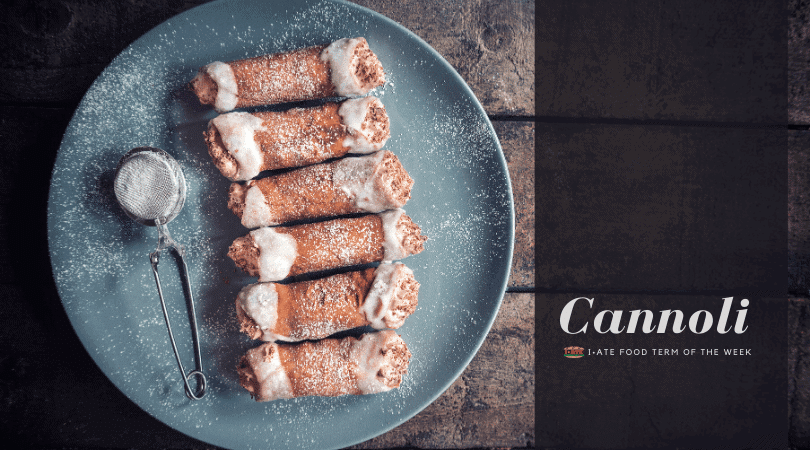 Tracing the origins of the term cannoli is quite challenging due to the legendary myths and emotional ties that have mixed and stratified in the collective memory.
Tracing the origins of the term cannoli is quite challenging due to the legendary myths and emotional ties that have mixed and stratified in the collective memory.
Etymologically, cannoli derives from Sicilian “cannolu” and Italian “canna” (reed or pipe). The denomination comes from the tool originally used to make the typical shape of cannoli, the “canna da fiume”, namely a long thin shrub growing near rivers. As a matter of fact, in the past the dough was rolled up in the trunk of this shrub in order to give cannoli their typical tubular shape. In Italian, cannoli is a plural name whose singular form is cannolo. As for its English counterpart, the Oxford English Dictionary reports its first occurrences back at the beginning of the XX century. According to its definition, cannoli are “deep-fried crisp pastry tubes with a sweet filling […] originally a speciality of Sicily”. The word has been incorporated into English language without much change, except for the formation of the plural which follows the morphology of English rules. Truth be said, the OED reports the form cannolis as a very rare plural form, but also cannolo is widely accepted as a singular form. Nonetheless, current attested usage testifies as the most established form is the loanword cannoli used as a collective noun. Specialised texts mention also the endearment form cannolicchi – cannulicchia in Sicilian language – which are smaller and considered as a mini size of the traditional fist-size pastry.
The origin of the cannoli recipe is born out of the inextricable tight of culture, conquest and tradition flourishing in Sicily during past centuries of foreign dominations. Back in the I century BC, Cicero already praised the precursor of cannoli, describing them as a “a tube-shaped waffle containing a sweet filling made from milk”. Ricotta cheese was surely the sweet filling he mentioned but at that time honey was used as a natural sweetener. It was Arabs that brought brown sugar to Sicily and since then sugar has been used as a sweetener in confectionery, including cannoli. During the Arab period, in the neighbourhood of present-day Caltanissetta, the women of the harem got inspired by Cicero’s pastry and mixed it with an Arab recipe made of almonds to create a treat in honour of their men. Nowadays we can trace the Arab origins of cannoli in similar sweets coming from the Islamic world such as Zainab’s fingers, whose ancient version resembles the shape of cannoli, and qanawāt, deep fried tubes whose name literally means “canal”, thus reinforcing the etymological bond with the Sicilian pastry.

The shape of cannoli recalls a phallic symbol, which at that time stood not only for virility but also for the prosperity of earth. This pleasure-loving message was imported also during the Middle-Ages when cannoli were served during the cheerful celebrations of the Christian Carnival. Generally, they were consumed in the spring due to the bigger production of sheep milk for ricotta cheese as in this season pasture lands are richer.
In Modern times, confectioners enriched the cannoli recipe putting in the ricotta mix flavours that exalt its Sicilian birth. Depending on the areas, apart from ricotta cheese, the filling may contain sugar, chocolate chips, grinded nuts and candied fruit. Some of these can abound or be omitted and recipes from one side of the island to the other usually cross-contaminate. Serial cannoli tasters state that near Palermo, apart from ricotta, the filling contains chocolate chips, while candied citrus skin towers above each cannolo; going eastward, near Catania, cannoli are filled with ricotta, chocolate chips, candied fruits and a bunch of grinded pistachio. This addition pays a tribute to the green nuts growing under the slopes of Volcano Etna.
The ricotta taste is actually what an expert on cannoli would notice at once, since ricotta cheese from sheep milk is stronger than that obtained from cow milk and if you use the latter the result would consist in a dramatic change on the flavours. Non traditional fillings vary and the curious taster is spoilt for choice in this case, since cannoli are also filled of custards flavoured with pistachio, chocolate, orange or lemon. Even if cannoli should be enjoyed when they are freshly filled, nowadays bakers coat the inside of the shells, alias the “scorza”, with dark chocolate. This prevents its softening and the shells can be filled also hours before. But, forewarned is forearmed, you should consume cannoli within a few hours from their preparation!
Last but not least, which is the best way to eat cannoli? Ideally, in a good Sicilian confectioner’s! Make sure the inside is cold and smooth and the “scorza” is crunchy. If you are not satisfied with it, you can make a complaint on its softness and a proud Sicilian confectioner would be happy to restore you with another crackling cannolo!
Sources
Krondl, M. (2011). Sweet Invention: A History of Dessert. Chicago Review Press.
Freedman, P. (2007). Food: The History of Taste (illustrated ed.). University of California Press.
Treccani. Online edition http://www.treccani.it/vocabolario/cannolo/
Merriam-Webster. Online edition https://www.merriam-webster.com/dictionary/cannoli
Oxford English Dictionary https://en.oxforddictionaries.com/definition/cannoli
Online Etymology Dictionary https://www.etymonline.com/word/cannoli
The Concise Dictionary of World Place-Names http://www.oxfordreference.com/view/10.1093/acref/9780199580897.001.0001/acref-9780199580897
Author: Carmen Serena Santonocito, PhD student in “European Languages and Specialized Terminology” at the University of Naples “Parthenope”

